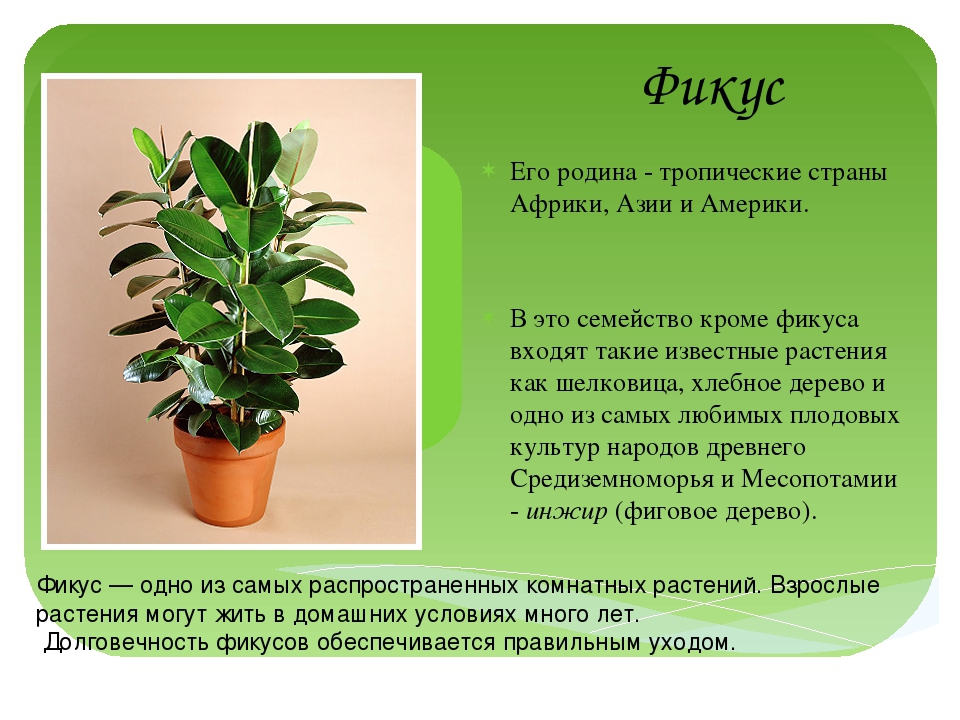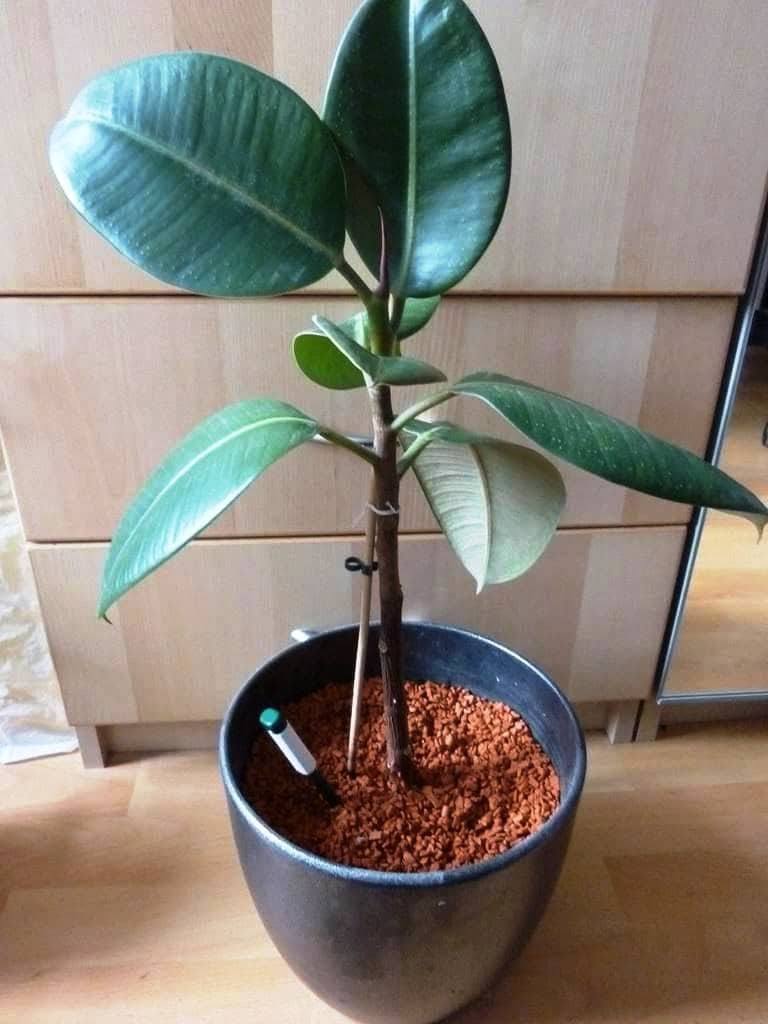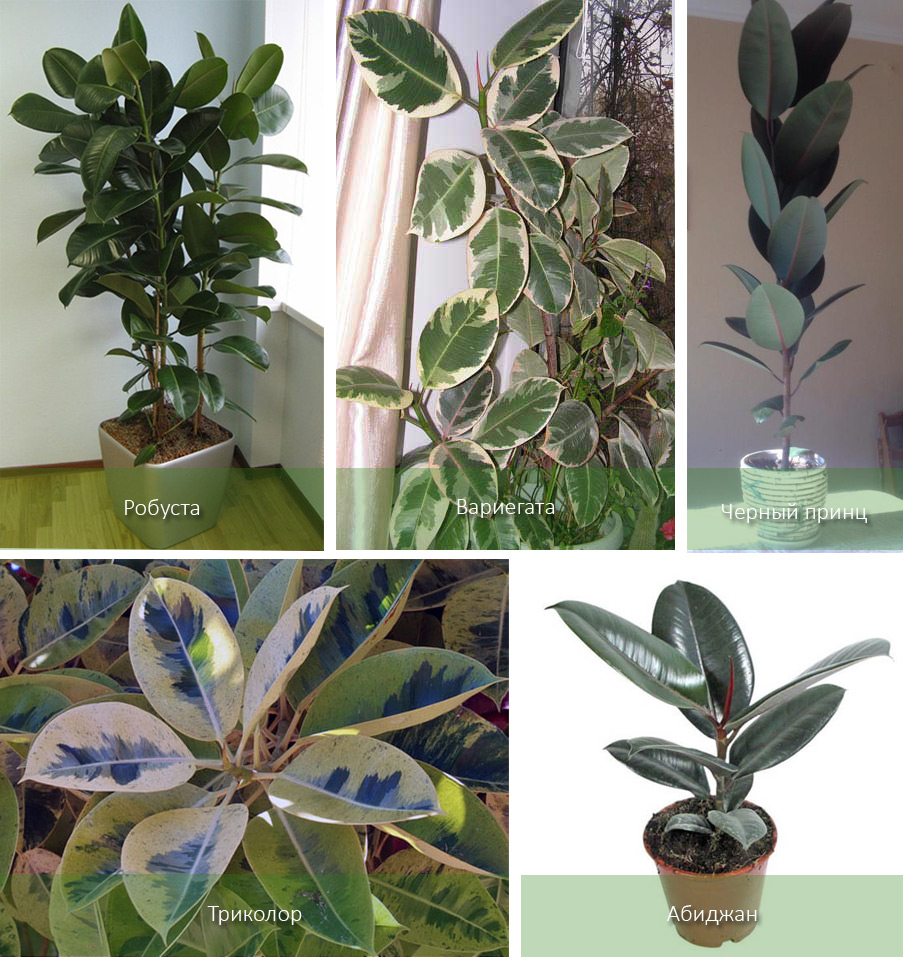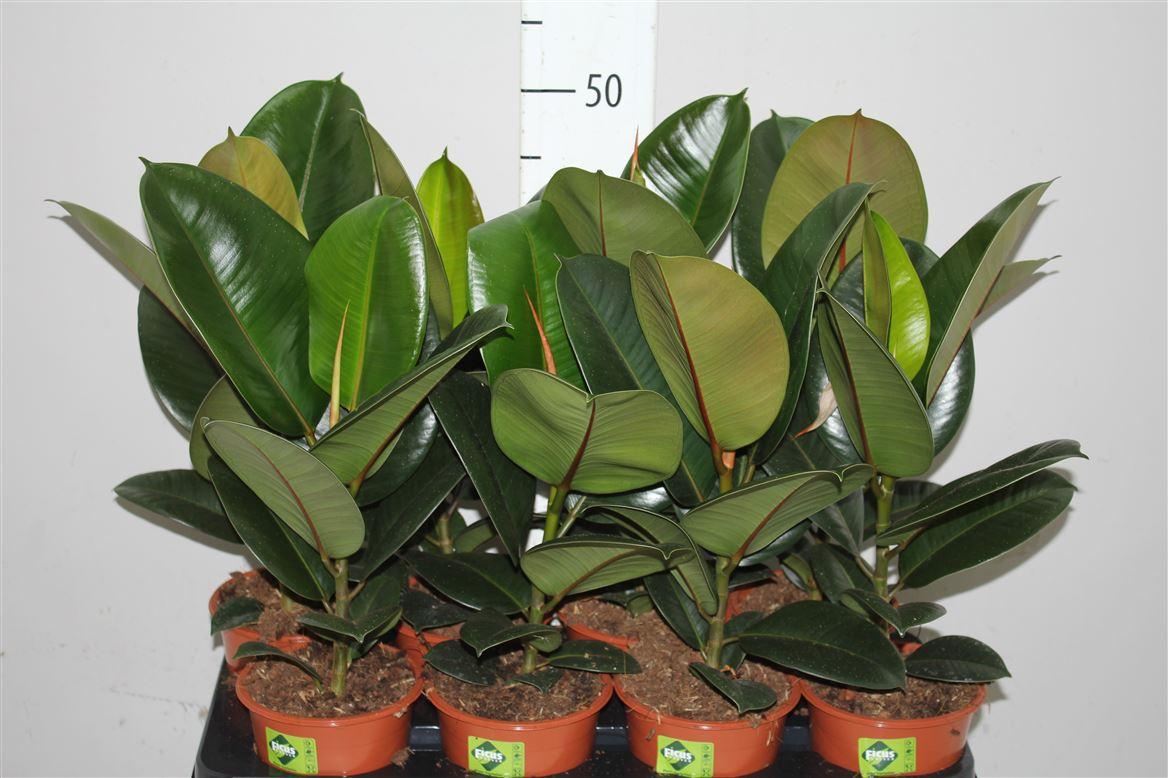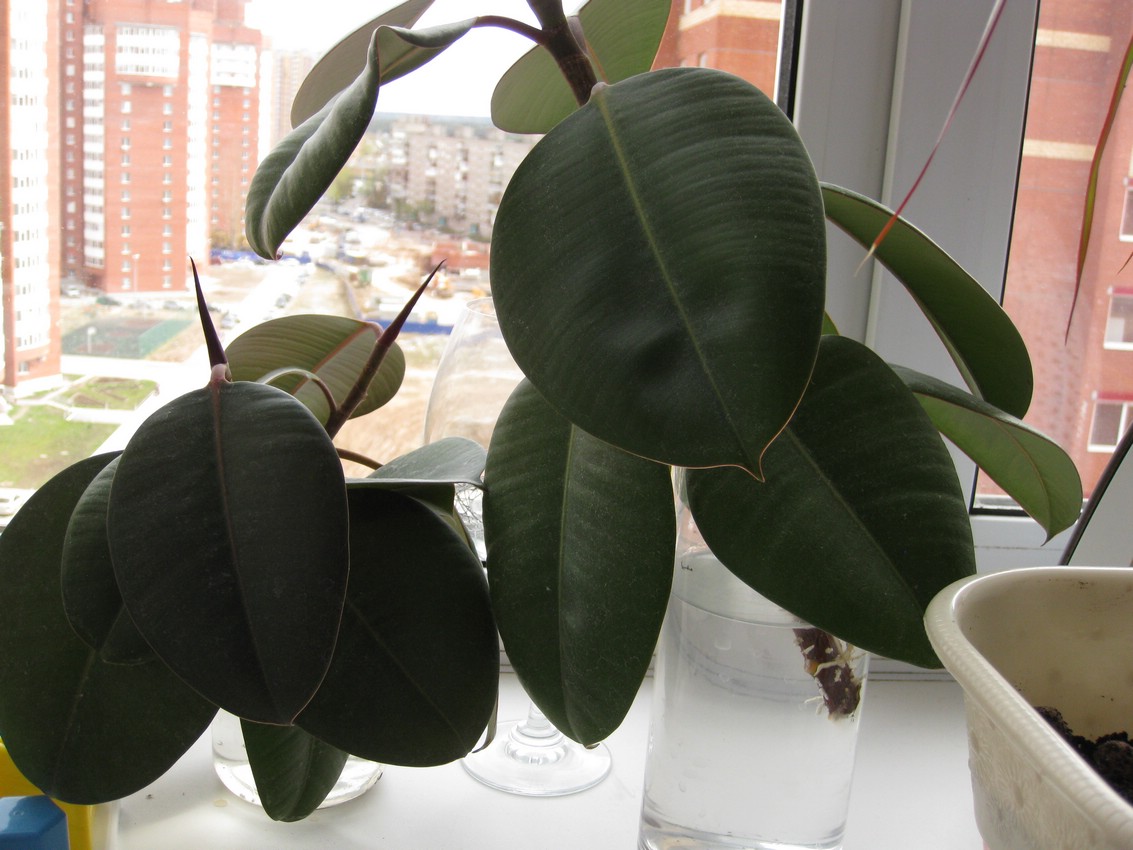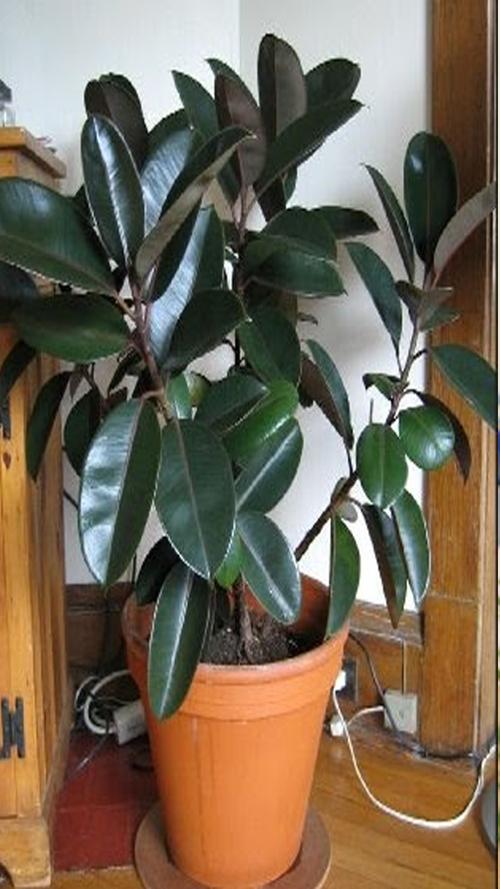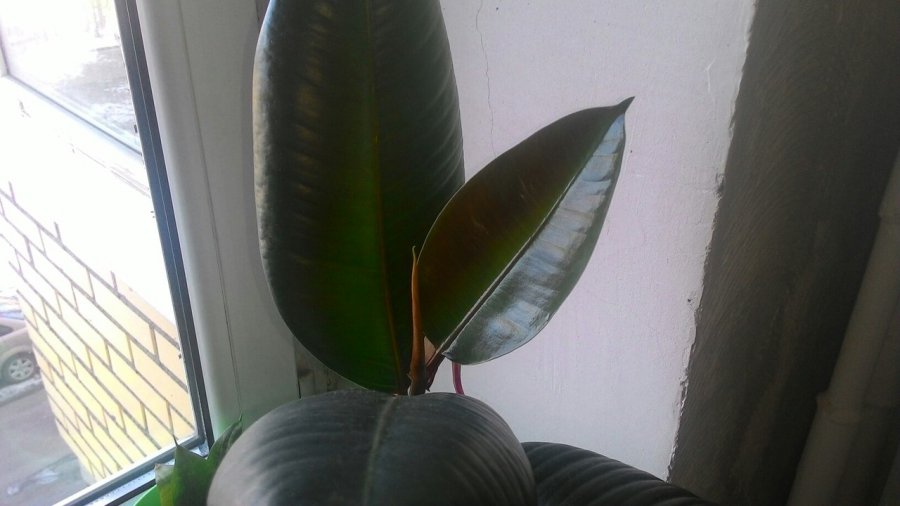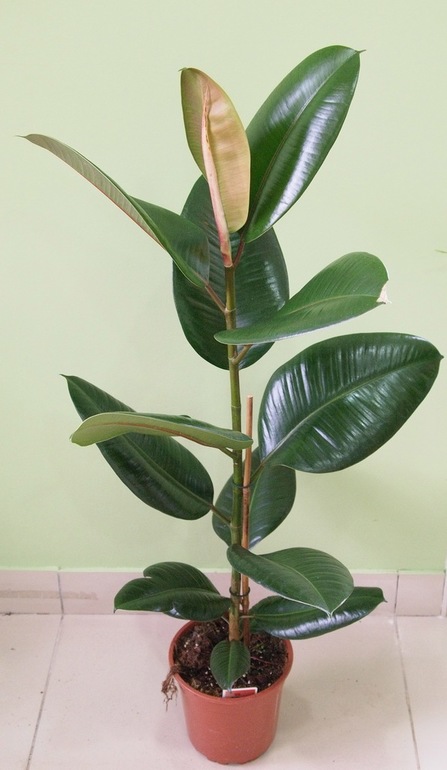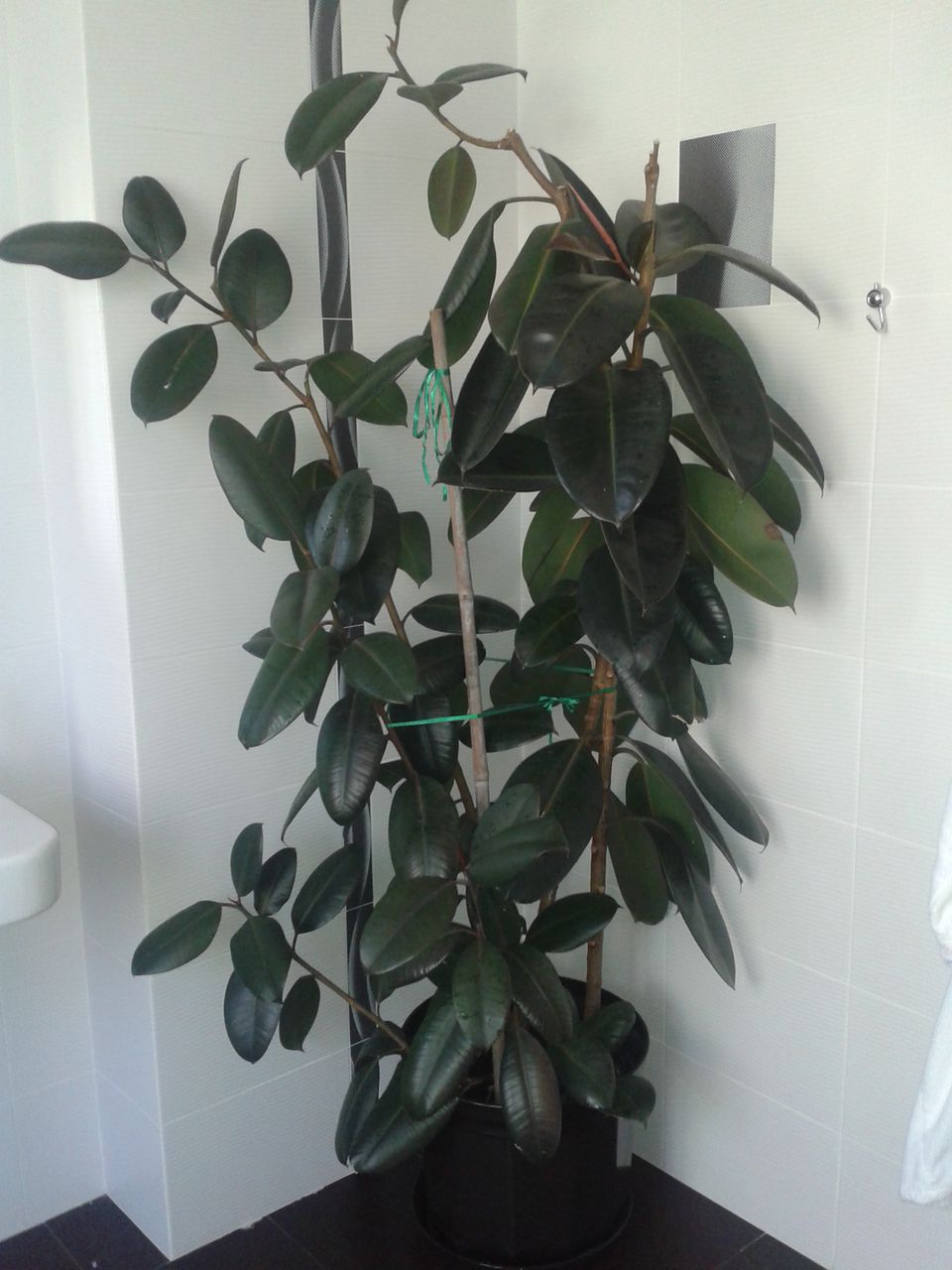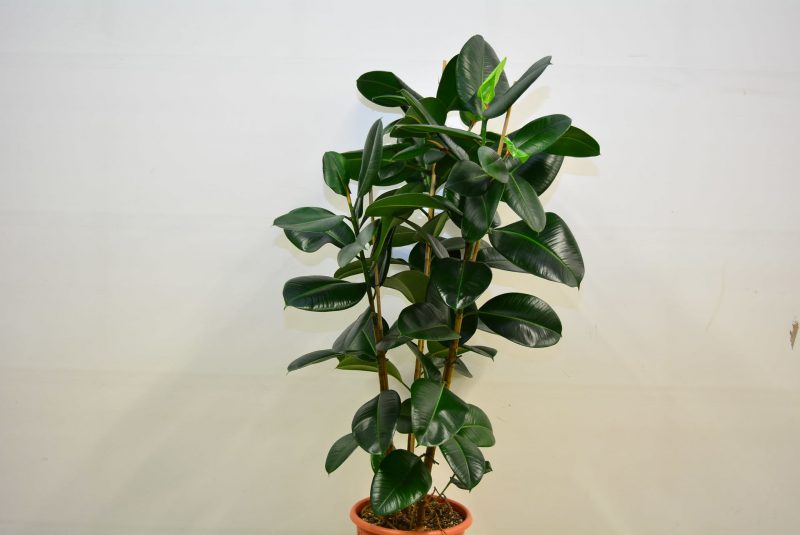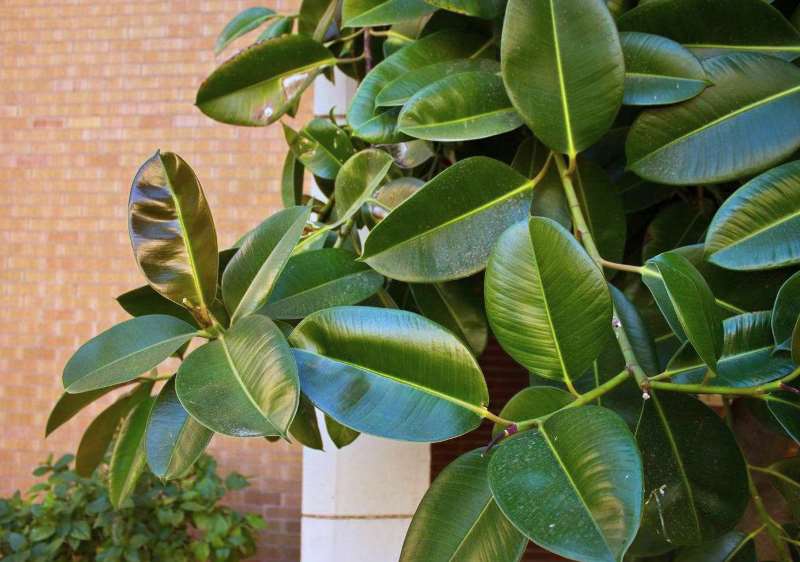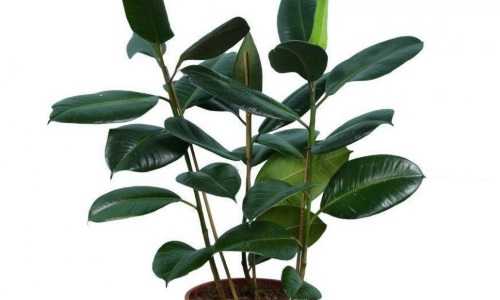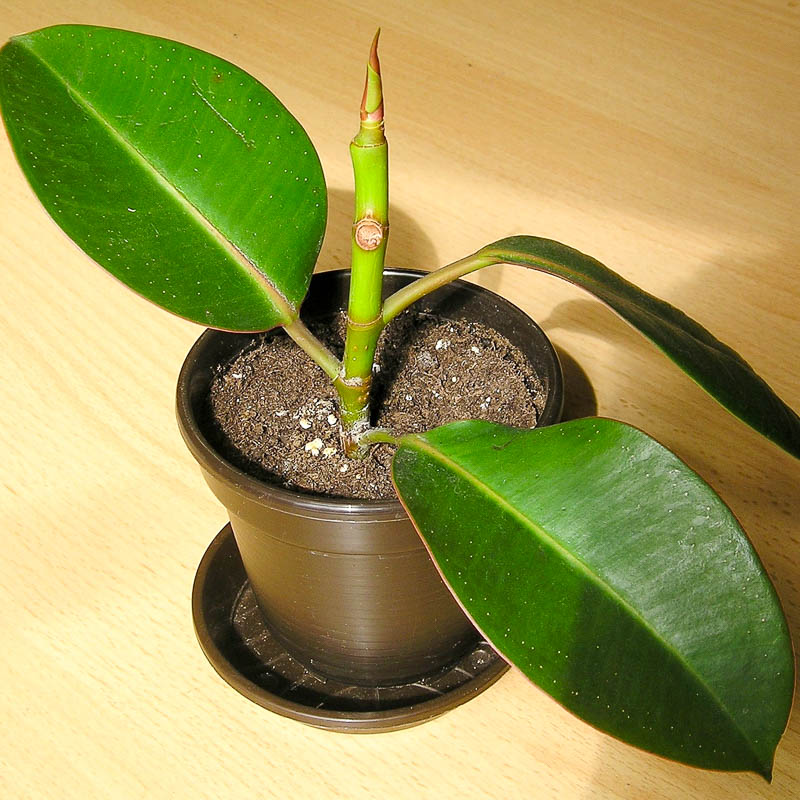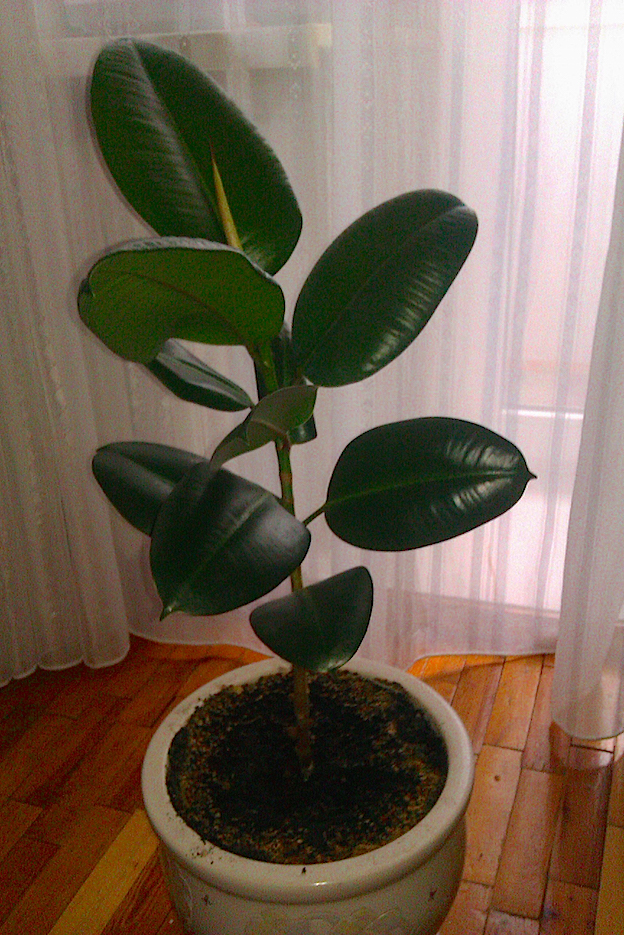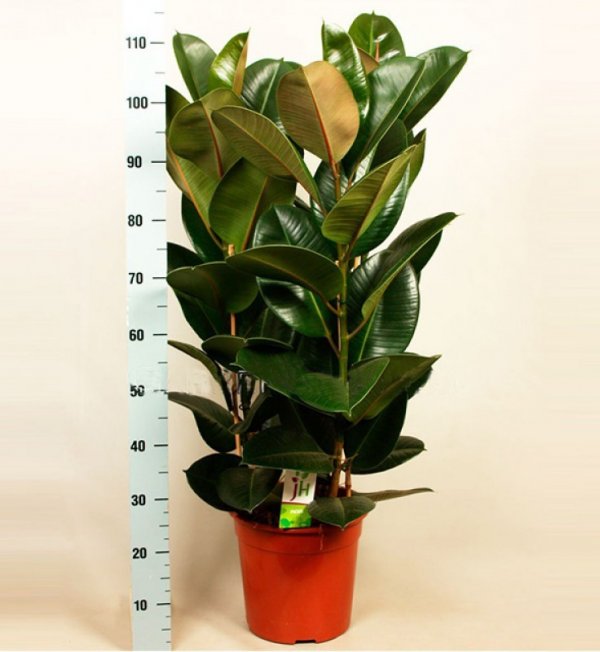Reproduction of ficus robusta
Like most representatives of the species, the Robusta ficus can be propagated in several ways: by cuttings, layering, seeds, leaves. In all cases, it is good to use phytohormones to accelerate root formation.
Cuttings
This method is the most convenient and widespread. The best time for him is the last week of winter - the beginning of spring. As a planting material from which ficus propagates, you can use any cuttings: green, half or completely lignified. Moreover, the apical specimens are preferable to those taken from the middle of the shoot.
The procedure is as follows:
- slices of stems with 2 - 3 leaves are cut from the tops of the shoots;
- milky juice is washed off from the cut points so that it does not clog the conducting vessels;
- within an hour, the sections are air-dried;
- prepared planting material is planted obliquely in containers filled with light earth with sand or clean sand.
In large-leaved ficuses, and this is exactly what Robusta is, before planting, the leaves are twisted into a tube, they are tied up, and the seedling is tied to a peg to give it stability, which is stuck into the ground through the center of the tube.
The cuttings take root within 20-60 days. Rooting will take place faster in the presence of soil heating, an air temperature in the room of 24-28 ° C and a humidity of about 80%.
Caring for cuttings consists in keeping the soil in a constant state of moisture and spraying on the leaves. To maintain the humidity at the required level, the cutting can be covered with a jar or plastic bag, not forgetting to open it from time to time for ventilation.
Layers
The second most popular breeding method at home is by layering. This is a great opportunity to bring back to life a plant that has lost the lower part of the crown. From adult ficuses for layering, you can take fully formed shoots and even whole branches, which will be much larger in size than any cuttings.
The procedure is as follows:
- an oblique incision is made on the branch you like for the appearance of roots;
- so that the incision does not close, a match is inserted into it, they wrap this place with wet moss, and on top of it with black plastic wrap;
- until roots are formed, the moss is kept moist by adding water under the film with a syringe.
After 2-3 months, when the roots are formed, the branch along with the roots is cut off and planted for rooting in a light nutritious substrate.
Leaves
Only strong and healthy specimens are chosen as planting material for leaf propagation at home. They are cut off along with a piece of the shoot. The cut is made obliquely, impregnated with some kind of root formation stimulant.
For the appearance of roots, the cut off shoot is placed in a bowl with warm, settled water or wet cotton wool. The sheet itself should not touch the water. When roots appear on the cut piece of the stem, a cup is planted for rooting. The process of germination of roots can be skipped in water, immediately after treatment with root-forming stimulants, plant them in a light nutrient substrate, cover with a glass cover or plastic wrap and leave for rooting.
Seeds
This method is usually used in cases where it is difficult or impossible to get material for grafting or cuttings. In order not to be disappointed with the result, it is advisable to buy seeds from well-established, trusted sellers.
Before planting, it is advisable to soak the seeds in a biostimulator for several hours. Then they are laid out on the surface of the soil moistened with a spray bottle. If the planting material is of high quality, seedlings appear in a week.
Pruning
You can rejuvenate the adult ficus Robusta by pruning. It should be remembered that the cut part of a houseplant is suitable for propagation by cuttings.
Pruning should be done in late February or early March. If the plant has not reached the required height, then only the tip of the central shoot should be pinched. For more serious crown formation, pruning should be carried out seven centimeters above the location of the desired leaf or branch. It should be remembered that trimming and pinching the central shoot completely stops the growth of the stem.
Features of caring for the exquisite Cattleya orchid

Thin branches are cut in a straight line. When trimming the stem, an oblique cut should be made. In this case, the upper part of the cut will be located above the kidney, and the bottom of the cut will be on the opposite side and located at the level of the kidney.
Pruning is done with a sanitized sharp knife or secateurs. You can disinfect the pruning tool by calcining over a fire or treating with alcohol. After pruning, you will need to remove the milky juice a sponge dipped in water.
You may also be interested in the article in which we talk about the features of home cultivation of the Elastic ficus.
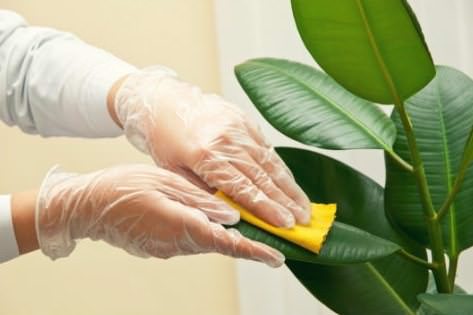
Appearance
Ficus robusta (Ficus robusta) or elastic ficus (Ficus elastica) is an evergreen tree from the Ficus genus, the Mulberry family, the Ficus rubbery species. The native land of the plant is the south of Indonesia (the islands of Java and Sumatra) and the southeast of India (the state of Assam). In their natural environment, the ficus Elastica Robusta looks massive, and can grow up to 60 m in height, while other representatives of the species reach a maximum of 40 m.When grown in a pot for a home or office, a bush ficus or tree stretches in height to an average of 2-3 m ...
Robusta has very decorative leaves - alternate, large (10-20 cm wide and 20-30 in length), dense, leathery, with a glossy sheen, regular oval shape with smooth edges and a sharp, slightly elongated tip. Older leaves are dark emerald, young leaves are pinkish brown. The central vein is clearly visible. Its color ranges from yellow to deep red.
Unlike many indoor ficuses, Robusta blooms in the house. But its yellowish-green inflorescences are so small and invisible that their flowering practically does not change the appearance of the tree. Then in their place appear small, about a centimeter in diameter, oval fruits - syconia. Like flowers, they have no decorative value. You can’t eat them either.
In nature, Robusta forms many long and strong aerial roots. Due to this feature, in India it is used for the cultivation of "living" suspension bridges. Thrown across a river or gorge, they represent the oldest examples of arboarchitecture - a trend that practices the use of living flora at the basis of building structures.
Diseases and pests of rubber ficuses
Ficuses are quite resistant to diseases and pests. If you follow the basic rules of care, water the ficus correctly, diseases will bypass it. So, if the ficus suddenly began to lose foliage, the reason for this may be excessive soil moisture or a strong drying out of the earthy coma, cold drafts, and lack of light. If the tree-like ficus is gradually losing the lower leaves, then this is a natural process and there is nothing to worry about.
In ampel and bush ficuses, dry and wrinkled leaves indicate insufficient air humidity and drying out of the soil. It is necessary to spray the plant more often and water it correctly. The same symptoms can occur with sunburn. In this case, it is necessary to find a more suitable place for the plant, where there is no direct sunlight.
If you notice small spiders on the underside of the leaves of the ficus, this is a spider mite.It multiplies very quickly in dry air and at high temperatures. It is destroyed by thorough washing, especially of the lower part, of the leaves with a weak infusion of tobacco dust (4 tablespoons per 1 liter of water), to which soap or infusion of Dalmatian chamomile with soap is added. After two hours, the leaves are washed with warm water.
If dots and spots appear on the leaves, it may be a shield aphid. This pest is also destroyed by soap-tobacco infusion, to which it is good to add a little denatured alcohol or kerosene. In this case, it is necessary to carefully examine the plant and remove all the shields from the leaves and stems with a cotton swab. The purity of the leaves is the main protection of ficuses from diseases and pests.
Home care
A tropical plant requires the following home care rules:
- compliance with the watering regime;
- timely feeding;
- transfer.
Watering
In summer, this type of ficus requires abundant watering. Watering is carried out when the soil ball has dried by 2 cm, but if the substrate is wet, it is not recommended to water it. Despite the fact that the ficus needs moist air, an excess of water in the soil will have a bad effect on the plant.
Check out the features of watering ficus at home.
In order for the earth to absorb water faster, it must be loosened. Water for irrigation should be separated, at room temperature. It takes a week to settle the water, after watering it is worth draining the water from the saucer, since bacteria can start in it.
Top dressing
This type of ficus must be fertilized during the period of active growth in early spring and until autumn, twice a month. Fertilizer for feeding should be liquid. The dose of minerals should be twice less than indicated on the package. Fertilizer can be purchased at specialty stores or prepared.

To prepare fertilizer yourself, you will need:
- ammonium nitrate - 5 g;
- phosphate - 0.5 g;
- salt - 0.1 g
Pruning
The optimal period for crown formation is at the beginning of spring, during a period of active growth. In the fall, the plant rests and growth stops, so no pruning is carried out at this point. The top must be cut off so that only the trunk remains, then the plant will begin to branch. It is necessary to create a crown symmetrically, while the shoots can be manually directed in different directions.
Learn how to properly prune ficus at home.
Transfer
The tropical flower is a fast growing plant and requires frequent replanting, preferably in the spring. Young plants need to be replanted once a year, and adults - once every 3 years. At the time of transplanting, a third of the pot is filled with drainage from broken bricks, pebbles, or the soil that is used for the aquarium.

Before use, the soil is calcined in the oven for disinfection, and treated with a weak solution of potassium permanganate. When transplanting, the roots are not separated from the soil, the plant is planted in a new pot along with a lump of earth. This plant does not like to be disturbed, rearranged from place to place. After planting a flower in a new pot, he needs to rest, the plant cannot be touched during this period for two weeks. Then the plant can be placed in its original place.
Important! The volume of the new transplant pot should be 3 cm larger than the previous one.
Features of plant care
Tineke ficus care is straightforward. This plant is unpretentious, but you should not neglect the basic rules of care.
Watering rules
Watering the ficus is necessary with settled warm water at room temperature. This should be done when the top layer of the earth dries out. Watering frequency depends on external conditions (temperature, humidity). Usually moisturizing is done 2-3 times a week. In the cold period, watering is reduced to 1 time in 7 days. Watering with cold water is unacceptable.
Important! Ficus Tineke does not like waterlogging - this can cause the appearance of a number of fungal diseases.The plant responds well to spraying with soft water from a spray bottle, especially during the hot summer season
Periodically, you should wipe the ficus leaves with a damp sponge and once a month organize a warm shower.
The plant responds well to spraying with soft water from a spray bottle, especially during the hot summer season. Periodically, you should wipe the ficus leaves with a damp sponge and once a month organize a warm shower.

Top dressing
In order for the Tineke ficus to grow well, it must be fertilized. The plant is fed once every 2 weeks during the active growing season (March-September). For this, mineral fertilizers are used, which can be bought in a specialized store.
You can also use the following fertilizers for feeding:
- A solution of nitrophoska in a ratio of 1 tsp. for 1 liter of water. This solution is poured over the ficus after moistening.
- Infusion of mullein. It is also added to the soil after watering.
In winter, feeding is reduced or minimized.
Pruning
Throughout the year, sanitary pruning is done as needed, removing old, dried or diseased leaves. Periodic pruning of old shoots is recommended to stimulate the emergence of new ones.
Important! On the slices of the Tineke ficus, milky juice appears, which can cause allergic rashes on the skin, therefore, work on pruning the plant should be carried out with protective gloves.
Pruning is also carried out to form the crown, because the plant grows quickly and can stretch to the ceiling. This procedure must be carried out in late February or early March.

Transfer
When the grown Tineke ficus grows cramped in the pot, it needs to be transplanted into a large container. This procedure is carried out in the spring (March-May). Young specimens are transplanted once a year, and adults (over 5 years old) - once every 3 years. A new pot is taken 2-3 cm larger than the previous one, or a little more than the root system.
It can be made of any material, but it must necessarily have a drainage hole. Expanded clay or broken bricks are used as drainage. Adult large ficuses are not transplanted, but the topsoil is replaced by 3 cm 1 every 2 years.
Also learn how to properly transplant ficus at home.
The transplant is done by the transshipment method as follows:
- Ficus is watered before being removed from the old container.
- A drainage layer is lined at the bottom of the new container, and a little soil is poured on top.
- Then the plant is carefully removed along with the earthy clod so as not to damage the roots.
- The plant is placed in a new container and covered with soil, keeping the flower in an upright position. The soil is tamped a little and made sure that there are no voids.

Crown formation
Ficus Tineke grows quickly, so its growth must be limited and the plant formed. If the flower needs to be formed in the form of a bush, then pinch all the shoots at a height of 10-15 cm. After this procedure, lateral branches begin to grow. When they reach the same length as the rest, they should also be pinched. The shoots that are directed inside the bush are not cut off at first, but when the ficus grows and begins to thicken, they remove excess internal shoots in order to ensure normal illumination of such a bush.
Did you know? In India, in the city of Cherrapunji, a local attraction is the living suspension bridges grown from elastic ficus. To do this, the aerial roots of the plant are directed across a stream or river to the other side.
If the ficus has a well-developed main shoot, then it is formed in the form of a tree. For this purpose, cut off all the shoots, leaving only 3-5 of the top ones. When the ficus grows to the required height, the tip is pinched, and the lateral processes are removed. All cut sites are gently wiped with a cloth and sprinkled with crushed activated carbon to avoid the ingress of harmful bacteria and infections.In order for the shoots to grow evenly on all sides, the pot with the plant should be periodically turned towards the window in different directions in a circle.

Features of seasonal care
Important nuances:
spring is the growing season, a good time for hygienic pruning, pinching the top and forming the crown. Feeding is carried out with mineral and organic fertilizers, watered moderately, keep a flowerpot with ficus in a warm, but not hot room (about + 23 ° C);
summer. The growth period continues, the flower becomes more luxuriant, many young leaves and side shoots appear (provided that the top is pinched in time). Top dressing twice a month, loosening is useful. The room should be warm
In the heat, it is important to spray the flower every day or wipe large leaves with a damp cloth or soft washcloth;
autumn - the beginning of the dormant period (from October), slow motion of juices. Top dressing is not performed, watering is rare, but too dry soil is a bad option
It is imperative to move the flower pot with ficus to a cool room (about + 16 ° C). You can not take the plant out to the balcony in the cold: at temperatures less than +13 degrees, disease and death of a tropical flower is possible;
winter. The decorative leafy species is resting, the rest period continues. It is impossible to carry out crown formation and hygienic pruning, watering is very rare, fertilizers are temporarily not applied. The dormant period gives the plant time to prepare for the growing season with the onset of spring. The plant is in a cool room, but there should be no dampness and "deep" shade: moderate light is needed.
Growing conditions
Let's find out what conditions the ficus robusta prefers.
Temperature
The best for ficus is room temperature - too much heat, as well as excessive coolness, are not suitable. That is why in our country the plant is cultivated exclusively as an indoor plant. If the temperature reaches +25 degrees and goes higher, the leaves begin to fade, sag and fall off.
The plant categorically does not accept cold weather. Even in winter, ficus should not be kept at temperatures below +15 degrees. If you violate this recommendation, the flower will respond by dropping the foliage.
The pot must be installed in a place of the apartment where there is no access to drafts. Ficus does not tolerate drafts and reacts sharply negatively to them.
Air humidity
The plant needs moderately humid air - at least 50%. The best option is humidity from 60% to 70%. You can not put the pot near working heating radiators, since the latter greatly dry the air. In winter, when the batteries are working with might and main, it is recommended to spray the ficus leaves from a spray bottle to moisten them.
Ficus robusta is undemanding to lighting and can feel quite well both in a sunny room and in a shaded one. If the place is completely dark, an artificial light source will easily solve the problem.
Do not expose the ficus to direct sunlight - this can lead to burns on its leaves.
Let's get acquainted with the main features of planting and rooting of ficus.
Soil preparation
Ficus robusta will do well in a light soil with low acidity. You can buy land for ficuses, which is sold in all flower shops - the easiest and best option. It is necessary to lay a drainage layer at the bottom of the pot - expanded clay or sand will do quite well.
Breeding features
Ficus robusta can be propagated in several ways:
- leaf shoots;
- cuttings;
- seeds;
- layering.
In amateur home cultivation, the grafting method is most often used. Planting material is obtained after pruning an adult plant.
The stalk is placed in water, and when the roots grow, they are transplanted into the prepared soil. As a rule, the plant takes root without problems, and soon it actively begins to grow.
What does the rubber ficus look like, which family does it belong to?
Ficus Elastica is considered a popular plant that is used to decorate rooms. The plant culture belongs to the Mulberry family, the homeland is India and Indonesia.

Ficus Elastic in a pot
Common varieties
The following types of rubber ficus are distinguished:
- Robusta. Differs in thin leaves of light green color, which eventually darken to dark green. The plate can be up to 50 cm long and 20 cm wide. A characteristic difference of the subspecies is a pronounced central vein on both sides.
- Melanie. The leaves of this plant are glossy, their shade is rich green. In bright light, they acquire a red tint. The leaf plate is wide, the tips are slightly bent back. Unlike Robusta, it grows small - up to 50 cm.
- Burgundy. Ficus has purple leaves that reach 30 cm in length and 10 cm in width. The central vein is red, not very pronounced. The flower cap is bright red, the petiole is pink.
Interesting! Variegated ficus is also very popular.
Healing properties
What are the useful properties of ficus:
- Cleans the air from harmful vapors, converts them into amino acids.
- Releases active substances that increase performance, restore sleep.
- Favorably affects the energy of the living space - it helps to cleanse the surrounding space from anger and anxiety.
- Paints the interior with beautiful green leaves.
Many skin pathologies can be treated with the leaves of the plant.
History of appearance
Ficus rubber, or elastic ficus, belongs to a species of plants in the Mulberry family. He arrived in Russia from northeastern India and Indonesia. In these countries, its dimensions were more impressive - up to 30 meters in height.

Rubber plant on the window
It received the addition "rubbery" to its name for obvious reasons. Isoprene is found in the milky sap of the plant. From it, rubber is obtained, which is used to make rubber.
Reproduction of a rubber plant
Florists practice four main methods of propagation of this plant.
Leaves
For this purpose, strong and undamaged leaves with internodes are selected. Reproduction by leaves is carried out in several stages:
- The leaf is cut obliquely, partially capturing the shoot. The cut can be treated with a root stimulant.
- The sheet plate is placed in a container with water or wrapped in wet cotton wool. Only the shoot should be in the water, the plate itself should not come into contact with it.
- When the shoot grows roots, it is planted in a small bowl with a nutrient substrate and covered with polyethylene or a cut plastic bottle. The rooted leaf is then transplanted into a permanent pot.
Important! The leaf should not be planted until the milky juice formed on the cut dries out.
The water step can be skipped. In this case, immediately after treatment with a stimulant, the shoot is placed in a nutrient substrate and covered with plastic wrap. It will take about a month to wait for root formation.
Layers

The procedure for reproduction by layering is carried out as follows
- The branch is freed from the leaves and neat oblique cuts are made on it at a distance of 3 cm from each other.
- To prevent the incision from overgrowing, a spacer (for example, a match) is inserted into it, wrapped in wet moss, and wrapped on top with plastic wrap. The structure can be fixed with tape.
- Moss should be regularly moistened by injecting moisture with a syringe until roots are formed (within 2-3 months).
- After the formation of the roots, the branch is cut with them and planted in a permanent pot with nutritious soil for rooting.
Cuttings
Cutting is the simplest and most convenient method most often used by flower growers. Cuttings are usually carried out in early spring. Any cuttings are used as material for planting: young, partially or completely woody.
Important! For this method, specimens from the top of the crown are best suited.
Cutting includes the following steps:
- The stems are cut diagonally at a distance of two to three leaves from the top of the shoot.
- The cut sites are washed from milky juice and dried.
- The cuttings are placed at an angle in a container with nutrient soil with the addition of sand. It is recommended to strengthen each stalk with a support. You can also place the planting specimen in water and, after the roots appear, transplant it into the ground.
Rooting takes place from one to two months. You can speed it up by slightly warming up the soil.
To care for cuttings, it is necessary to regularly moisten the soil and spray the leaves. To maintain humidity, you can organize a kind of greenhouse by covering the stalk with plastic wrap or a plastic bottle.
Video about ficus cuttings:
Seeds

It is very important to purchase seeds from reliable sellers, as only the use of quality raw materials can guarantee a satisfactory result. Robusta seeds are planted as follows:
Robusta seeds are planted as follows:
- before planting, the sowing material is pre-soaked for several hours in a biostimulator;
- then the seeds are spread on a pre-moistened soil surface, without embedding them in the ground;
- the first shoots should be expected in a week.
Ficus Robusta does not require special care and feels great in indoor conditions, so even novice growers can breed it. It is only necessary to take into account some of the features of the content of this plant, and then it will decorate your home or office for a long time.
Diseases and pests
Ficus Elastica is almost not exposed to pests. A spider mite sometimes appears on the leaves of the flower. To combat this pest, the leaves of the plant are washed under a stream of cold water, having previously covered the soil of the container. Wipe the leaves with wet wipes.
After water procedures, the pest completely disappears. A plant can only get sick from unsystematic care. The most common manifestations are shedding of leaves, discoloration and stun growth. A plant can get sick from any stressful situation.
Ficuses get sick from excess or lack of sunlight, insufficient watering, winds, drafts, high room temperatures, dry air. Sometimes illnesses appear several months after uncomfortable conditions. Ficus Elastica rubbery Robusta responds well to feeding.
Can grow in partial shade on the gray side. The flowering of the plant is almost imperceptible. In natural conditions, trees reach the 60-meter mark.
Useful video for home care for rubber ficus:
Florists grow many wonderful plants in their homes. And one of the most popular representatives of the botanical world is the ficus robusta - it is capable of both decorating the interior and giving it solidity and representativeness. And of course, like all plants, ficus can purify the air, improve the microclimate of the home. We will learn how to grow ficus robusta: how to plant a flower and how to care for it.
The plant is also called Elastica Robusta or rubbery ficus. This is an unpretentious ornamental plant that a novice florist can also grow. Caring for him is not troublesome, and the handsome ficus is undemanding to the conditions of detention.
The flower is a representative of the popular ficus family, it has evergreen fleshy leaves characteristic of plants of this kind. Foliage is the most remarkable part of the plant, precisely because of the large, glossy leaves of the ficus robusta and is bred at home.
The color of the leaves is interesting - the general background is dark green, while in the middle there is a vein with a contrasting lighter or red color. Young leaves at the top of the plant are usually red at first, and only then turn green.All leaves are located along the trunk in a strict sequence.
The barrel, by the way, also has a green color. The length of one leaf is 20-25 cm, in width they reach 15 cm. There are also large specimens, with leaves of huge sizes - about 45x20 cm. Photo of the flower on our website.
Robusta also blooms. However, the flowers and the fruits that appear then do not have any special decorative value, and their size is small (1 cm in diameter).
Such a ficus, even at home, is capable of reaching a height of two meters. Therefore, it is often used for landscaping institutions, offices, spacious shops.
Ficuses with green leaves
Ficus elastica Robusta is the most popular among flower growers. In most cases, it has one straight stem extending to the very ceiling. Its leaves are large, oval, up to 30 cm long and about 15 cm wide, rich green, smooth, glossy, very dense, with a curved tip. It is difficult to force it to grow as a bush. If you cut off the top of this ficus, several lateral buds begin to come to life, but, as a rule, one grows, giving the same single stem. The rest of the buds or their young shoots freeze. But the ficus Robusta among its fellows is considered the most patient and undemanding. You can make it release side shoots by not only cutting off the top, but also tilting the stem. Then the upper kidney will begin to develop. When several leaves appear on it, the stem is straightened. Some growers make punctures on the stem with a needle (about 1/3 of the thickness). This stimulates the growth of the kidneys.
Another popular type of ficus elastica plant is Abidjan. Outwardly, it looks like Robusta, only its leaves are much darker, and their tip is pointed, but not bent. When Abidjan is properly lit, the foliage becomes dark beetroot with red veins. This type of ficus is also quite unpretentious and undemanding.
Ficus elastica Melanie (pictured above) branches perfectly without human effort. Its leaves are smaller than those of the two previous species. In length they grow up to 15 cm, and in width - up to 7. Their tip is bent. The plant looks very beautiful, as the leaves are compactly located on the branches. If you take care of it properly, you get a neat lush bush. This species is a little capricious, loves regular spraying, requires nitrogen, does not tolerate drafts, permutations and dust on the leaves.
Diseases and pests, methods of control
Ficus is a fairly strong plant, but if the rules of care are violated, fungal diseases develop. Most often, the reason lies in root decay, abundant watering, the use of cold water, or an excess of fertilizer.
Ficus diseases:
- Anthracnose.
- Cercosporosis.
- Botrytis.
For treatment, first remove the affected leaves, replace the soil, treat all parts of the bush with fungicides. Effective antifungal agents: Skor, Fundazol, Topaz.
Pests on rubber ficus:
- spider mite;
- false shield and shield;
- mealybug.
Wrestling:
- eliminate the factors provoking the colonization of parasites;
- move rubber ficus to quarantine in a separate room, away from other species from a green corner;
- inspect the plant, remove all found adult parasites, eggs and larvae;
- apply a soap solution, cover the plant with cellophane so that the pests suffocate, wash off the folk remedy;
- treat the bush with acaricides (when ticks are detected) or insecticides (to destroy harmful insects);
- transplant the flower into a new flowerpot with a fresh, high-quality substrate;
- after 7-14 days (taking into account the requirements of the instructions), re-treatment with insecticides or acaricides is carried out.
Tropical juice contains irritating ingredients. For this reason, it is imperative to protect your hands with medical gloves.During pest control and elimination of ticks, it is imperative to prevent the negative effects of chemicals on the hands, face, mucous membranes, organs of vision and respiration.
Ficus robusta: general information
This type of ficus can be safely called the most unpretentious plant, which is perfect for novice florists. Caring for him will not cause much trouble.
Check out the most popular types of ficus, in particular with lyre, rubber, myocarp, Melanie and Benjamin ficus, and learn how to propagate ficus at home.
Appearance and photos
This flower is a member of the ficus family. The evergreen crown will not leave indifferent any grower. Most of all, it is notable for its large leaves. They are oval in shape with pointed tips pointing downward.
The color of the leaves is dark green. In the middle of the shoot is a central vein, the color of which can vary from red to dark green.
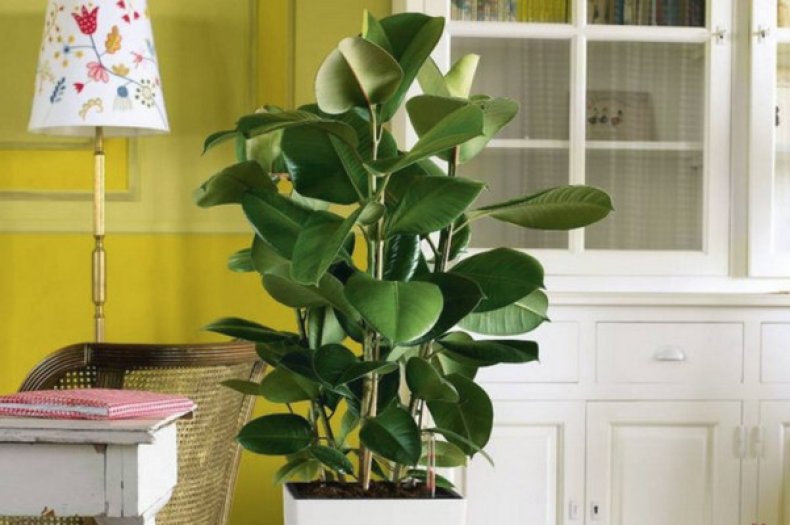
The deciduous plate has an even edge. The leaves are arranged sequentially along the entire trunk, which is green.
If you touch the surface of the leaves, you get the impression that they are made of plastic with a wax coating. The length of the leaf is approximately 20-25 cm, and the width is 15 cm.However, in some plants, the leaf can reach 45x20 cm.
Did you know? In feng shui, the robusta indoor flower is a symbol of purifying the aura and protecting against negativity and evil spirits of the living space.
Robusta can also bloom. However, the size of the inflorescences and fruits is insignificant compared to the size of the flower (only 1 cm in diameter), so it is very difficult to see them.
Homeland and distribution
Ficus robusta is very common in the northeastern regions of India, as well as southern regions of China, Indonesia, Nepal, Burma, Burana and Malaysia.
The length of some members of the species can reach 60 meters in height. However, the average height of this tree is 30-40 meters, and the trunk diameter reaches 2 meters.

In nature, the trunk of a plant has many branches and can form aerial roots.




